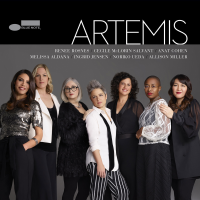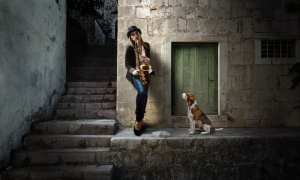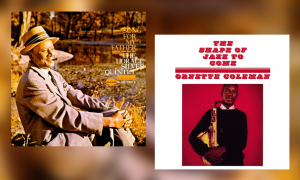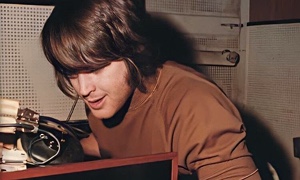Home » Jazz Articles » Building a Jazz Library » Charlie Parker: Ten High Flying Albums Of Paradigm Shifting Genius
Charlie Parker: Ten High Flying Albums Of Paradigm Shifting Genius

Bird was kind of like the sun, giving off the energy we drew from him. His glass was overflowing. In any musical situation, his ideas just bounded out, and this inspired anyone who was around. He had a way of playing that affected every instrument on the bandstand.
—Max Roach
Parker's recording career—which as a bandleader spanned just ten years—is well documented on studio albums, live recordings and radio transcriptions. His most influential work was released on 78rpm singles in the 1940s, since compiled on innumerable (and still counting) albums and box sets. Like the mostly 10" LPs that followed in the 1950s, these span official releases, pirate recordings and bootlegs, all of them repackaged and reissued on many different labels. The sheer scale of Parker's recorded legacy can be confusing to anyone starting a collection of his work. This article flags up nine of the most essential releases, plus a tenth which will be best appreciated by seasoned Parker Jedis.
Parker recorded on around a dozen labels during his career as a bandleader, which began in late 1944, a few years after he had moved to New York City. The bulk of his work was made for Savoy (1944-48), Dial (1946-47) and Norman Granz's family of labels, later collected under the Verve umbrella, (1948-54). The Savoys, Dials and Verves form the backbone of a Parker library and in due course aficionados will want to acquire the complete-sessions box sets available on all three labels. This article takes a middle path, including a single CD compilation of master takes (Savoy), a 4xCD complete-sessions box set (Dial), and a taster CD plus three stand-alone albums (Verve).
But first we rewind to Kansas City for a little pre-history....
CHARLIE PARKER: FLIGHTPATH
 Jay McShann Orchestra
Jay McShann Orchestra Blues From Kansas City: The Original Decca Recordings
GRP, recorded 1941-42, released 1992
Parker joined Jay McShann's KC band in 1937 but left after a few weeks. He rejoined in 1940, making his first commercial recordings with McShann in 1941, followed by others in 1942. Both sessions are included on this compilation, which is a superb introduction to the blues-and-riff-focused KC scene in which Parker arrived at technical maturity. The 1941 session includes the landmark track "Hootie Blues." Issued as a B-side, it contains a Parker solo that transfixed every forward-thinking musician who stumbled across it. The reaction of alto saxophonist Sonny Criss, as quoted by Ross Russell in his book Bird Lives! The High Life And Hard Times Of Charlie "Yardbird" Parker (Quartet, 1973) was typical. "The saxophonist was not identified on the label or in any of the reviews that appeared in the trade magazines," said Criss. "I only knew that some musician I might never meet or hear again had discovered a new way through the blues progression. That solo took me in a completely new direction." In 2020, "Hootie Blues" may not strike the listener as revolutionary fare but that is only because Parker's innovations have been so thoroughly absorbed in jazz.
Count Basie's Definitive Decca Best Recordings (Definitive, 1999), is another valuable introduction to the KC milieu Parker knew. When he was 14, the under-age Parker would sneak into the city's Reno Club under the wing of sympathetic Basie sidemen, and hide on an unused balcony a few feet above the bandstand, getting the full blast of the music plus, as he later recalled, the clouds of weed smoke that drifted upwards from the musicians. Though recorded in the late 1930s, after the Basie band had left Kansas City, the twenty-six tracks on the album are pure KC jazz of the period. One of Parker's formative influences, the tenor saxophonist Lester Young, is a featured soloist.
 Charlie Parker
Charlie Parker Bird: The Savoy Recordings (Master Takes)
Savoy, recorded 1944-48, released 1976
Parker left the McShann band immediately after the 1942 New York recording session documented on Blues From Kansas City. The band was going south on tour and Parker wanted to stay in town, where he was now a habituee of the after-hours bop cradles Minton's Playhouse and Monroe's Uptown House, laying the foundations for the new music alongside trumpeter Dizzy Gillespie, pianists Thelonious Monk and Bud Powell, guitarist Charlie Christian, bassist John Simmons and drummers Max Roach and Kenny Clarke.
In September 1944, for Savoy, Parker made his first small group recordings, under the leadership of ballad singer and guitarist Tiny Grimes. The date produced an early bop classic in Parker's instrumental feature, "Red Cross," which the band knocked off during the final minutes of the session. In November 1945, again for Savoy, he made his first recordings under his own name, leading a quintet which comprised Miles Davis (most tracks) and Dizzy Gillespie (one track) on trumpet, Gillespie and Sadik Hakim (one track) on piano, Curley Russell on bass and Max Roach on drums. Six tracks were recorded including two which came to define the first flush of fully fledged bop: the frenetic "Ko-Ko" and the loose-limbed, bluesy "Now's The Time." Between 1945 and 1948, Parker made another twenty small group masterpieces and near-masterpieces for Savoy.
 Charlie Parker
Charlie Parker Charlie Parker On Dial: The Complete Sessions
Spotlite 4xCD, recorded 1946-47, released 1993
In late 1945, the NYPD began a sustained campaign of harassment of the clubs along 52nd Street, the boppers main employment platform. City authorities suspected the Street was a centre of drug dealing (right) and also regarded it as a centre of race mixing (right again), both of which they regarded as reprehensible. Clubs were strong armed into changing their booking policy or closing down. To fill the vaccum, Parker's agent Billy Shaw secured him an eight-week gig at Billy Berg's club in Los Angeles, co-leading a band with Gillespie. LA was at the time virtually a bop-free zone, and one of the city's first bop converts was record-store owner Ross Russell, who set up Dial Records in order to record Parker.
LA also proved to be a pretty much heroin-free zone, too, with erratic supply lines and inflated prices. This was a crippling problem for Parker, who compensated with an even more destructive alcohol and barbiturates habit. Like Savoy's A&R man, Teddy Reig, Russell gave Parker free rein in the studio and the LA Dial sessions include many sublime examples of his art. They also include the infamous "Lover Man" session, at which Parker was so drunk he could barely stand up, but still managed to play some (painfully tortured) solos. After an enforced spell drying out in Camarillo State Hospital, followed by some more, vastly superior sessions, Parker returned to New York in April 1947. He received a hero's welcome from fellow musicians and found new performance opportunities had opened up at the Royal Roost and Bop City. Russell followed, and Dial recorded nineteen more outstanding titles with Parker between October and December. The collective personnel includes many of the bop greats—including trumpeters Gillespie, Miles Davis and Howard McGhee and tenor saxophonists Lucky Thompson and Wardell Gray, and less expected names such as pianist Erroll Garner and guitarist Barney Kessel.
The quality of the Dial releases is more varied than the Savoys, but the highs predominate and are so high that it is worth going straight to the 89-track "Complete Sessions" set, replete with its alternative takes. The collection has been pirated on cheaper editions, but the Spotlite original is distinguished by two authoritative liner booklets, "The West Coast Sessions" and "The East Coast Sessions," jointly written by Russell and Parker scholar and Spotlite founder, Tony Williams.
 Charlie Parker
Charlie Parker Charlie Parker: Verve Master Edition
Verve, recorded 1947-53, released 1998
Parker's most copiously recorded and least consistent period recording for one label was with Norman Granz. More interventionist in the studio than either Teddy Reig or Ross Russell, Granz arranged for Parker to record in a variety of contexts from small bands through larger ensembles. Some of these sessions were successful, others less so. The entire Verve catalogue is available on the 10xCD set Complete Charlie Parker On Verve, but is only worth thinking about once the complete Savoys and Dials have been acquired.
By 1948, Parker had recorded his most trailblazing work, but his default mode was still one of brilliance and sixteen of his best small-group (mainly quartet) recordings for Granz are collected on Verve Master Edition. The album also includes nine alternative takes. The collective personnel includes trumpeter Kenny Dorham, pianists Al Haig and Hank Jones, bassists Ray Brown and Percy Heath and drummers Buddy Rich, Max Roach and Shelly Manne.
Three notable albums which are not sampled in the collection are Charlie Parker With Strings, Afro Cuban Jazz and Bird And Diz.....
 Charlie Parker
Charlie Parker Charlie Parker With Strings: The Master Takes
Verve, recorded 1949-52, released 1995
Parker's recordings with strings have received bad press over the years. But Parker loved them, and the nay sayers need to lighten up. The arrangements (by orchestra leaders Jimmy Carroll and Joe Lippman) do, admittedly, tend towards the saccharine, but that is irrelevant—they provide sumptuous frameworks for Parker to channel his balladic side (as do others on the Verve compilation The Cole Porter Songbook, recorded 1950-54). The 24 tunes are top drawer treasures of the Great American Songbook including "April In Paris," "If I Should Lose You," "Autumn In New York," "They Can't Take That Away From Me," "Stella By Starlight" and "East Of The Sun (West Of The Moon)." Parker's motivation for working with strings was complex and almost certainly included a desire for approval from the musical establishment. Strange, given that his life was lived in defiance of establishment rules. But anyway, the results speak for themselves.
 Machito
Machito Afro Cuban Jazz
Mercury/Clef, recorded 1950, released 1951
Like the strings recordings, Afro Cuban Jazz, released under Nuyorican bandleader Machito's name with Parker a featured soloist, continues to divide opinion. Again, Parker himself loved them. This is a great album. The 18-piece band is mainly comprised of Machito's regular players, including a four-piece percussion session, and is augmented by Parker, tenor saxophonist Flip Phillips (a regular alongside Parker on Granz's Jazz At The Philharmonic concerts) and drummer Buddy Rich. The conductor is Chico O'Farrill, who also wrote the material, two side-long suites which take in in bop, mambo and rumba.
Dizzy Gillespie may have been the bopper who first embraced Afro Cuban music, but Parker proves himself equally adept at negotiating the rhythms. He is clearly having a ball and the feeling is infectious. One of O'Farrill's suites is included on a 1995 Verve compilation titled South Of The Border, released under Parker's name (with the primarily Nuyorican musicians additionally augmented by drummers Roy Haynes and Max Roach and trumpeter Benny Harris). There is not much to choose between the two albums.
 Charlie Parker & Dizzy Gillespie
Charlie Parker & Dizzy Gillespie Bird And Diz
Verve, recorded 1950, released 1952
Bird And Diz is an unmissable opportunity to hear Parker and Gillespie alongside fellow bop pathfinder, pianist Thelonious Monk. If Oscar Pettiford had been on bass and Max Roach on drums, five of the most important Minton's collaborators would have been present. But Curley Russell and Buddy Rich hold their own. Granz's decision to use Monk does him credit, because at the time Monk was still widely regarded by most jazz critics as a talentless primitive if not an outright charlatan. Rich is a great success, too, providing uncomplicated, hard-driving propulsion. Most of the tunes are up-tempo Parker originals, though there is an affectionately cheesy reading of Ernest Burnett's "My Melancholy Baby," which Monk deconstructs in inimitable fashion. In his sleeve notes, Granz describes the session as "a very happy date," and it sounds like it. The entire album is a joy.
(Incidentally, though Granz was an inveterate booster of his concert promotions and record releases, his sleeve notes could be disarmingly frank. In his notes for Stan Getz's Norgran album Interpretations, recorded in autumn 1953 shortly before Getz was jailed for attempting to hold up a Seattle pharmacy to score some morphine, Granz wrote: "[There is something] immature and undeveloped in the poignancy of his tone... when his playing lacks a certain vigor it is not because of a lack of musical ability, but rather the weakness of the man." Granz loyally supported Getz's family during his four-month incarceration. And in 1955, he paid for Parker's body to be flown from New York to Kansas City for burial).
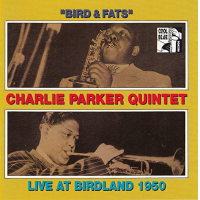 Charlie Parker Quintet
Charlie Parker Quintet Bird & Fats: Live At Birdland 1950
Cool & Blue, recorded 1950, released 1992
The fourteen tracks on this outstanding live album were recorded just eight days before trumpeter Fats Navarro passed at the tragically young age of 26. They catch him in blazing form. Recorded over two, possibly three, sets, Bud Powell and Walter Bishop, Jr. alternate on piano, Tommy Potter and Curley Russell on bass, and Art Blakey and Roy Haynes on drums. Navarro's solo on Sir Charles Thompson's "The Street Beat" justifies the much-overused word awesome. Other tracks include Thelonious Monk's "52nd Street Theme," Dizzy Gillespie's "Dizzy Atmosphere" and "Night In Tunisia," Denzil Best's "Move" and Parker's "Ornithology"—bop warhorses all but played as though for the first time. The entire album is magic.
Navarro's artistry was wholly his own but the presence of Parker may have been an additional inspiration at Birdland. In Robert Reisner's Bird: The Legend Of Charlie Parker (Da Capo, 1977), Max Roach is quoted saying: "Bird was kind of like the sun, giving off the energy we drew from him. His glass was overflowing. In any musical situation, his ideas just bounded out, and this inspired anyone who was around. He had a way of playing that affected every instrument on the bandstand."
The bottom line is, if you only get one live Parker album, Bird & Fats: Live At Birdland 1950 is the one to have. Definitely. Without a doubt. No contest.
Or maybe this one....
 The Quintet
The Quintet Jazz At Massey Hall
Debut, recorded 1953, released 1956
This spectacularly wonderful performance was given in front of six or seven hundred people rattling around in Toronto's 3,500 seat Massey Hall—when making the booking the New Jazz Society, a group of inexperienced Toronto jazz fans, was unaware that 15 May 1953 was also the date of the upcoming world heavyweight boxing championship between Rocky Marciano and Jersey Joe Walcott, a white/black face-off which would be broadcast live across the USA and Canada. Yet the musicians—Parker, Dizzy Gillespie, Bud Powell, bassist Charles Mingus and Max Roach—play with all the fire they would bring to a packed New York club. The set includes killer versions of Tadd Dameron's "Hot House" and Gillespie's "Salt Peanuts," "Wee" and "A Night In Tunisia," on which Parker's solo-opening cadenza recalls the version known as "The Famous Alto Break" recorded for Dial in 1946.
Just who arranged for the gig to be recorded is unclear. In his (breathtakingly self-laudatory) autobiography To Be, Or Not... To Bop (Doubleday, 1979), Gillespie asserted it was Mingus. "Do you know," wrote Gillespie, "that Charlie Mingus took advantage of his position on the bandstand, tape recorded the concert, went home and put out a record? I ain't seen no royalties until recently." But in his book Quintet Of The Year (Aurum, 2002), Geoffrey Haydon revealed that the tapes were made by a Canadian Broadcasting Corporation engineer engaged by NJS president Dick Wattam, and that after the gig, Mingus put them under his arm and took them away, telling NJS member Roger Feather, "They're mine." What is certain, however, is that Mingus rerecorded his bass before issuing the album on his Debut label. But all that, as they say, is showbiz. The music is a harmonious triumph.
 Charlie Parker
Charlie Parker The Complete Dean Benedetti Recordings Of Charlie Parker
Mosaic 7xCD, recorded 1947-48, released 1990
If the probably apocryphal wax-cylinder recording said to have been made by trumpeter Buddy Bolden in New Orleans in the 1900s is the holy grail of jazz, then the legendary Dean Benedetti recordings of Parker are of equal importance. The discs (7xCDs or 10xLPs) comprise the lost-for-forty-years covert recordings Benedetti made of Parker solos and breaks on New York and Los Angeles bandstands between March 1947 and July 1948 (without the club owners' permissions but with Parker's approval). After completing the project, Benedetti discovered he had a terminal illness and travelled to Italy to live out his days at his parent's house, taking the Parker tapes with him. He passed in 1957. The tapes stayed in a trunk under Benedetti's bed until 1988, when they came into the possession of his brother, who had the good taste to take them to archivists Mosaic Records.
The Complete Dean Benedetti Recordings Of Charlie Parker is probably for seasoned Parkerphiliacs only. There are 263 tracks, some lasting a few seconds, others a few minutes: Benedetti aimed to turn his machine on when Parker began to solo and off again as soon as he stopped. The tracks are stacked up one after another, like an epic-length book written without punctuation, and after half an hour or so, listening becomes an out of body experience. It is a long, strange trip. But it is also a great one, in the company of an immortal genius.
Tags
PREVIOUS / NEXT
Support All About Jazz
 All About Jazz has been a pillar of jazz since 1995, championing it as an art form and, more importantly, supporting the musicians who make it. Our enduring commitment has made "AAJ" one of the most culturally important websites of its kind, read by hundreds of thousands of fans, musicians and industry figures every month.
All About Jazz has been a pillar of jazz since 1995, championing it as an art form and, more importantly, supporting the musicians who make it. Our enduring commitment has made "AAJ" one of the most culturally important websites of its kind, read by hundreds of thousands of fans, musicians and industry figures every month.


